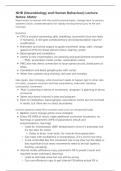NHB (Neurobiology and Human Behaviour) Lecture
Notes: Motor
Need motor to interact with the world (communicate), change input to sensory
systems (vision, somatosensation for rapidly moving stimuli (you’re the one
moving))
Evolution
● CPG is ancient (swimming, gills, breathing, locomotion (but not really
in humans)), it still gets somatosensory and proprioception input for
modification
● Brainstem and sense organs to guide movement (stop, start, change
speed of CPG) for distal stimuli (vision, hearing, smell)
● Basal ganglia and cerebellum
● Cortex is new (mammalian), for planning and goal directed movement
○ PMC, association motor cortex, association cortex
● PMC also has direct connection to local spinal circuits, distal parts of
limbs
● Cerebellum and basal ganglia grew with cortex
● When new systems stop working, old ones are revealed
Idea (goal), plan (strategy, what movement needs to happen (get to other side
of room)), program (muscles and their parameters), execution (sending
commands), movement
● ‘Plan’ is planning in terms of movement, ‘program’ is planning in terms
of muscle
● Same structures involved in plan and program
● Parts of cerebellum, basal ganglia, association cortex are not involved
in motor, but there are no sharp boundaries
Control systems (need FB to counter noise such as unexpected load)
● Ballistic (can’t change action once initiated)
● Direct FB (NFB of result, make additional correction movement, no
learning) or parametric (NFB of parameters (result and
proprioception), learning)
○ Used for homeostasis (ABP, temperature) since it’s automatic but
it’s too slow for motor
◆ Delay to brain, from brain, for muscle force generation
○ Can cope with oscillations in homeostasis, if it’s not for too long
○ To be controlled like this movement has to be slow (so the delay is
less significant) but many movements need to be fast (speech,
hunting, escaping)
● Internal model (efference copy, parametric FB to predict result and
required motor command, learning)
○ Used to estimate noise but can still be wrong
○ Can use efference copy to get internal FB before actual FB is
, ○
available (waiting for result is slowest step)
○ If a step is off by 2cm, you trip, because your overtrained FF
system predicted incorrectly
Spinal cord -> muscle
Spinal cord
● Intermediate zone of integration, interneurones
● Ventral horn is somatotopic (flexor posterior, extensor anterior,
proximal medial, distal lateral)
● Motorneurone pool is for one muscle
○ Motorneurones receive synapses from interneurones (sensory and
descending information), some proprioception, some direct
descending pathways for specific systems
○ Motorneurone disease (no positive signs, need to eliminate
everything else)
◆ Potential causes
◆ Motorneurone degeneration: ALS (motorneuone disease),
polio infection
◆ Peripheral nerve damage: autoimmune dymelination
(Guillain Barre syndrome), physical damage
◆ Spinal cord damage: vertebral column dislocation
◆ Lose innervation, atrophy or more receptors, more sensitivity,
fasciculations
Muscle
● Motor unit is muscle fibres (all the same type) innervated by one
motorneurone (so subset of whole muscle)
● Muscle fibres
○ Slow, fast fatiguable (FF), fast fatigue resistant (FR)
○ Slow is low force and long-lasting for marathon, FF is high force
and short-lasting for sprinting, FR is intermediate
○ Can train to make one type more dominant (usually FF)
● Force encoding
○ Frequency of AP in motorneurone, but muscle tetanus
○ So also recruit motor units
◆ Slow motor units, then medium, than fast
◆ Size principle, next recruited unit is smallest increment in
force, ensures fine control of force
◆ Plasticity (no brain involvement), low threshold motor neurones
innervate few fibres and they become slow; and vice versa for
high threshold
Proprioceptors (muscle part of somatosensory system) (proprioception
involves more than proprioceptors such as Ruffini ending mechanoreceptors)




